News
The birth of EIIRIS: Toyohashi Tech launches the Electronics-Inspired Interdisciplinary Research Institute
Toyohashi Tech is renowned for its innovative approach to research. Examples include the 'Toyohashi Probe' (Fig.1) for capturing electrical signals from living cells and the innovative CCD-based pH sensor for visualizing pH levels in liquids (Fig.2).
Now, building on its tradition of cutting-edge research, and with a view to meeting industrial demands to nurture graduates with more diverse expertise, the University launched the Electronics-Inspired Interdisciplinary Research Institute (EIIRIS) on 1st October 2010. (Figs.3–4)
The EIIRIS infrastructure is a unique environment for conducting world-class interdisciplinary research, and houses an international team of young and ambitious researchers from diverse fields including neuroscience, magnetic materials, solid state electron devices, and robotics. Research at EIIRIS will address major issues including the environment and aging societies.
For related information see feature article: EIIRIS spells an innovative approach to interdisciplinary research
EIIRIS website: http://www.eiiris.tut.ac.jp/
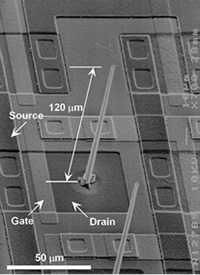
Fig. 1: The Toyohashi Probe developed by Makoto Ishida's team, consisting of an array of perpendicular nano-wires grown on a silicon chip for interfacing with living cells.
http://www.int.ee.tut.ac.jp/icg/
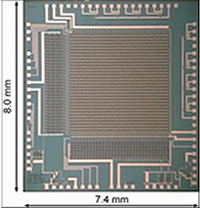
Fig.2: The pH chip developed by Kazuaki Sawada' team enables the visualization of the distribution of pH levels in a test solution.
http://www.int.ee.tut.ac.jp/icg/
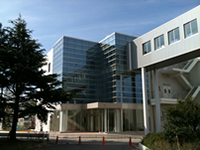
Fig. 3: The new dedicated building housing researchers of the Electronics-Inspired Interdisciplinary Research Institute (EIIRIS).

Fig.4: The new EIIRIS icon and symbol mark
Open Campus 2010: Toyohashi Tech welcomes visitors to the Tempaku Campus
The annual Toyohashi Tech Open Campus day was held on Sunday 29th August 2010. Around 2000 visitors joined the festivities for a first-hand look the education, research, and community activities undertaken by the University.
In his opening speech, President Yoshiyuki Sakaki (Fig.1) welcomed visitors to the Open Campus, and encouraged them to visit the research demonstrations, educational and recreational facilities, and club activities prepared by students and staff for this special day (Fig.2).
The Open Campus day was also an opportunity to learn more about the innovative new curricula and courses offered by Toyohashi Tech directly from members of the academic staff.
Visitors experienced the international tastes, music, and languages in events organized by international students—approximately 10% of the students at Toyohashi Tech are from overseas (Fig.3).
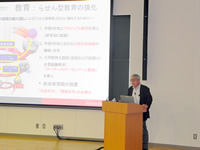
Fig.1: President Yoshiyuki Sakaki welcoming visitors to the Open Campus at Toyohashi Tech.
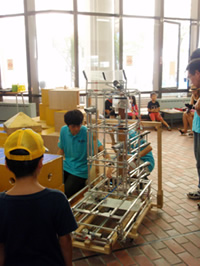
Fig.2: Students of the Robotics Club discuss their project with visiting high school students.
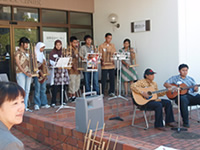
Fig.3: Members of the Indonesian Student Association
Omotehama Blue Walk: Preserving a precious beach for migrating sea turtles to lay their eggs
The Toyohashi Tech campus is only about four kilometers from the spectacular 50 km long Omotehama beach. A small part of this beautiful beach is a venue for international wind surfing events. But the Omotehama coastline is even more famous as being the natal beach of migrating seas turtles, which lay eggs in the sand.
As part of Toyohashi Tech's efforts to support efforts to preserve the local ecosystem, every year the University joins hands with the local community for the 'Omotehama Blue Walk'—a nine day stroll along the 50 km Omotehama beach to collect discarded litter, and thereby maintain a clean and ecological friendly environment for future generations of sea turtles.
This year's Omotehama Blue Walk started on August 13th, and was organized by students and graduates of Toyohashi Tech in collaboration with members of the local community.
Under blue skies, the intrepid Blue Walkers were given a spirited send-off by Toyohashi Tech vice president Noriyoshi Kakuta. Around 600 people participated in the Blue Walk this year, trekking about 5 km each day, taking a rest and then continuing the following morning on their nine day voyage (See photographs of the walk). The Walk ended at Cape Irago, which is famous for the lighthouse and spectacular views over Mikawa-Bay .
- Further information
- Omotehama Network: http://www.omotehama.net/e_index.html
- Mikawa Bay: http://en.wikipedia.org/wiki/Mikawa_Bay
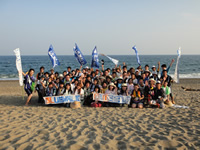
Time for a memorial photograph of the Omotehama Blue Walk 2010 event.
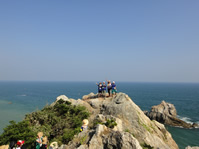
Spectacular views en-route to Cape Irago.
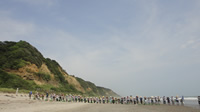
A long chain of Blue Walkers combing the beach for litter.
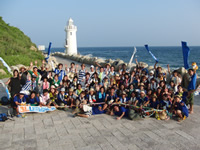
The famous lighthouse at Cape Irago, and the end of the 9-day Blue Walk.



